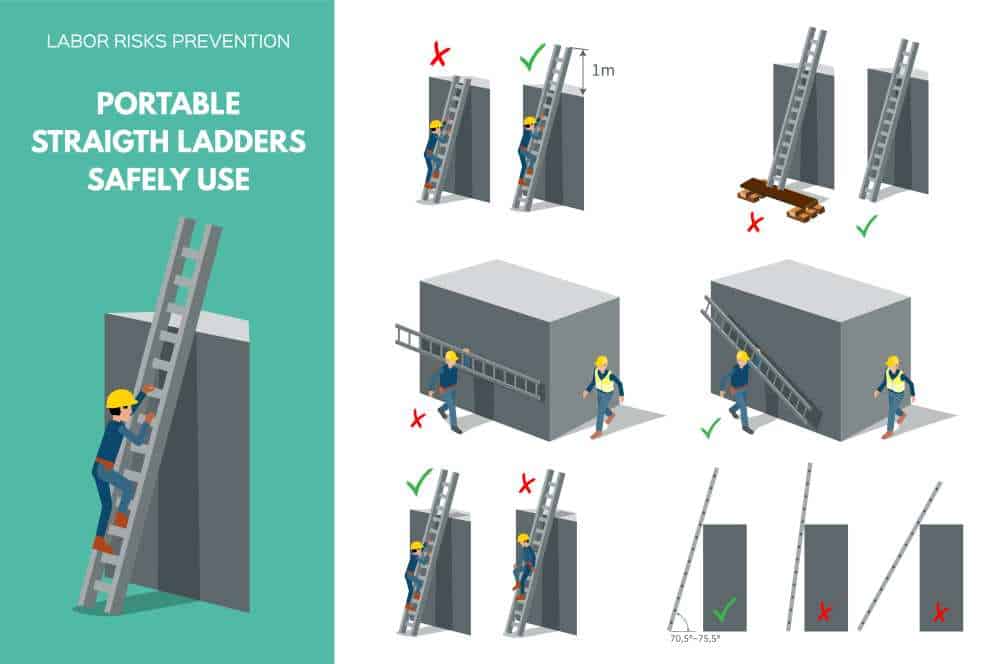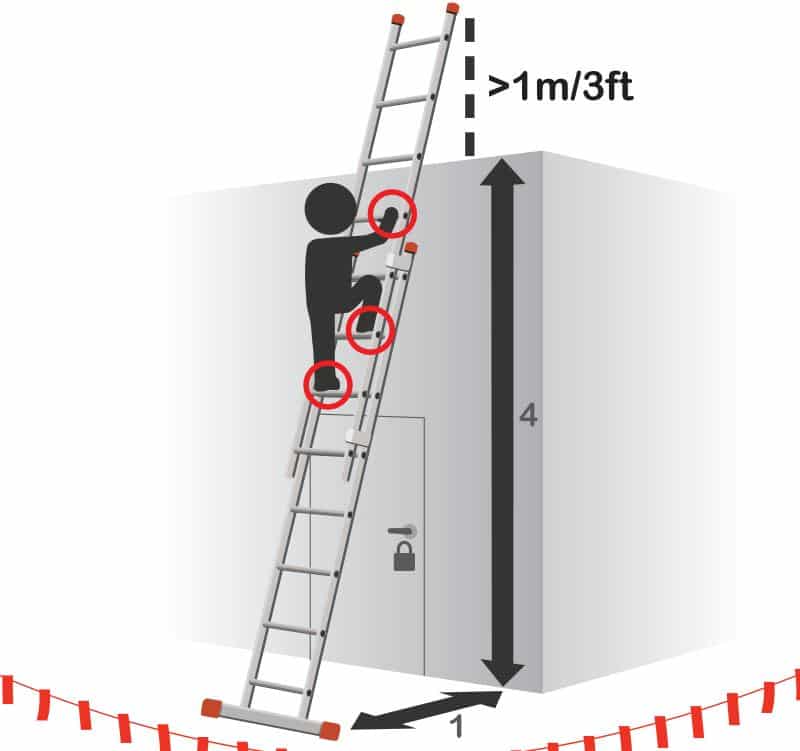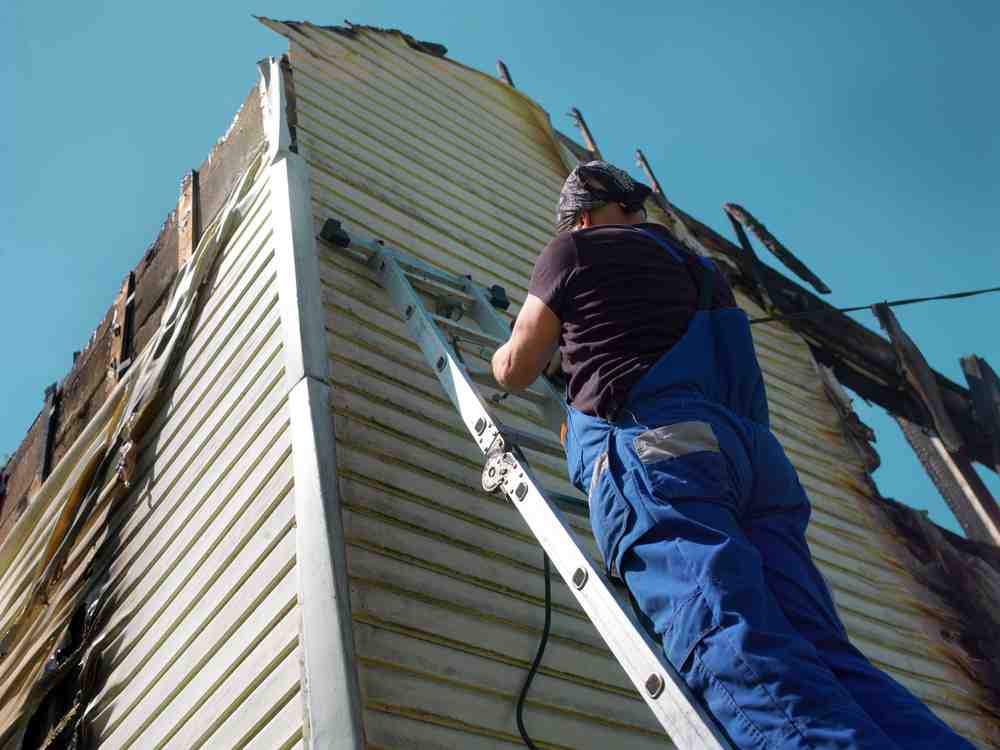Ladders are functional tools around the home, especially for DIY lovers who clean the gutters and fix the lights independently.
Ladders also come in handy when cleaning high areas in your house- such as kitchen cabinets, the attic, or high ceilings. Ladder safety is something that every ladder owner should have in mind.
It’s also essential to understand how to use a ladder safely. So, did you really know that a wrong angle of the ladder can cause a serious ladder accident?
Thus, let’s take a look at the proper ladder angle rule for safety purposes. A proper ladder angle is 1:4, which means 1/4 of your ladder height should be in angle.
So if you have a 20 ft ladder then it must be angled by 5 ft. It’s also called the 4:1 rule.
Proper ladder angle rule
There are different ladders, each suited for a particular type of job. Some common types include extension, platform, step stool ladders, A-frame, and pole ladders.
Each ladder is better suited for some tasks than others.
For instance, a step ladder is handy when you need to reach low places like cabinets and shelves, or you are also pretty good with step stools for those small jobs.
No matter what type of ladder you are using, always maintain the 4:1 ladder angle rule.
We have written a handy review on the 7 best safety step stool with handle, you might also want to check that out.
Ladder angle calculator
The ladder angle rule is the easiest way to stay safe when using a ladder. A safe ladder calculator is simply an easy way to calculate how to place your ladder to use it safely.
A ladder that does not support itself, such as an extension ladder, must be set at the right angle to ensure it remains sturdy and safe throughout.
There are two standard ladder angle calculator methods-
- 4 to 1 rule
- The stand and reach method.
These two methods are very popular ways of determining the correct ladder angle.
1. 4 to 1 rule
The 4:1 rule is as simple as it sounds.
The ladder must be put at a 75-degree angle, simply the 4:1 ratio.
The rule states that when using a single ladder, extension ladder, or whichever ladder cannot support itself, the ladder should be one foot away from the wall for every four feet of wall height.
For instance, use a 16 feet extension ladder to clean your gutters. Using the 4 to 1 rule, divide the 16 by 4 to get 4.
That means that the bottom of the ladder needs to be 4 feet away from the wall. The same goes for a 20 feet single ladder. The ladder’s feet need to be 5 feet away from the wall.
Determining angles using the bare eye can be challenging, but the 4 to 1 is an easy way to stay safe while using a ladder.
2. The stand and reach method
The second easy ladder angle rule is the stand-and-reach method. The method is straightforward to follow as all you need to do is-
- Stand facing the ladder you want to use.
- Place your toes against the rails’ front side at the ladder’s base.
- Extend your arm straight out.
You can also visit this website to learn more about ladder angles and other safety guides.
How does this help determine the right angle?
It’s very simple! If you can touch the rung closest to your shoulder with the palm of your hand without bending, then the ladder is at the correct angle.
You can keep adjusting the ladder until you have the right angle.
Proper ladder usage
Apart from measuring the ladder angle correctly, learning how to use a ladder safely is very crucial for safety; here are some proper ladder usage tips-
- Always ensure all the feet are working correctly and there are no cracks or chips on the feet.
-
Do not overreach, no matter how safe the ladder feels. Never stand on the last three rungs from the top to avoid toppling over.
- Ensure all the locking devices are working correctly before using the ladder.
- Only use light tools on the ladder and avoid exceeding the prescribed weight.
Important points to remember before you climb any ladder–
- Do not use the first three rungs of the ladder to avoid overreaching.
-
Avoid overloading, whether with excess tools or worker’s weight. The proper weight the ladder can take is always indicated on the ladder.
- For safety, always use the three points of contact when climbing.
- Use a tool belt when climbing instead of climbing with the tools.
The proper extension ladder angle rule is explained.
An extension ladder is convenient when it comes to reaching very high places such as high ceilings and gutters. These ladders can also be hazardous if proper care is not taken as they are leaning ladders.
To ensure you are using an extension ladder correctly and safely, ensure you are placing your ladder at a 75 degrees angle. The 4 to 1 rule must be applied for safety.
I also have an in-depth review on gutter cleaning ladders; visit this link to check that out.
I’ll highly appreciate it. Remember, you will not get the same height when you buy an extension ladder.
For instance, when you get a 16-inch ladder, you will only be able to use 14- or 15-feet maximum reach because of the overlap and fly section.
Also, keep in mind extension safety rules when using an extension ladder.
How far should a ladder extend above the roof?
When using a ladder to reach your roof for cleaning or painting, there are safety rules to look out for.
Apart from using a rightly angled extension ladder, ensure your ladder extends above the roofline so you don’t need to step on the last three rungs.
For instance, if you are working on a 22 feet roof, ensure you a ladder is higher than 22 inches.
You can also visit this link to learn more about it.
How far must a ladder extend above the landing?
A ladder should always extend at least 3 feet above the landing surface for safety when climbing on and off the ladder. Also, ensure you use a high-quality ladder to carry your weight.
Conclusion
You should always ensure that the ladder you are using, whether single standing or safety step ladder is at the right angle.
Also, ensure to cross-check the safety guides for assurance.




